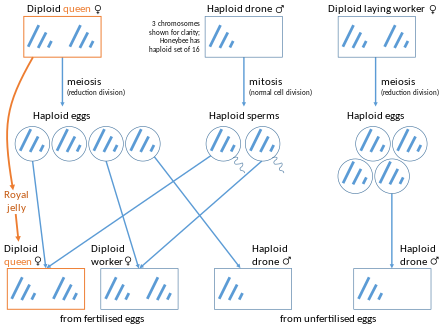Arrhenotoky

Arrhenotoky (from Greek ἄρρην árrhēn "male" and τόκος tókos "birth"), also known as arrhenotokous parthenogenesis, is a form of parthenogenesis in which unfertilized eggs develop into males. In most cases, parthenogenesis produces exclusively female offspring, hence the distinction.
Overview
[edit]The set of processes included under the term arrhenotoky depends on the author:[1] arrhenotoky may be restricted to the production of males that are haploid (haplodiploidy); may include diploid males that permanently inactivate one set of chromosomes (parahaploidy); or may be used to cover all cases of males being produced by parthenogenesis (including such cases as aphids, where the males are XO diploids).[1] The form of parthenogenesis in which females develop from unfertilized eggs is known as thelytoky; when both males and females develop from unfertilized eggs, the term "deuterotoky" is used.[2]
In the most commonly used sense of the term, arrhenotoky is synonymous with haploid arrhenotoky or haplodiploidy: the production of haploid males from unfertilized eggs in insects having a haplodiploid sex-determination system. Males are produced parthenogenetically, while diploid females are usually[a] produced biparentally from fertilized eggs. In a similar phenomenon, parthenogenetic diploid eggs develop into males by converting one set of their chromosomes to heterochromatin, thereby inactivating those chromosomes.[4] This is referred to as diploid arrhenotoky or parahaploidy.[5]
Arrhenotoky occurs in members of the insect order Hymenoptera (bees, ants, and wasps)[6] and the Thysanoptera (thrips).[7] The system also occurs sporadically in some spider mites, Hemiptera, Coleoptera (bark beetles), Scorpiones (Tityus metuendus) and rotifers.
See also
[edit]Notes
[edit]- ^ Unless in certain rare cases they too are produced by thelytokous parthenogenesis.[3]
References
[edit]- ^ a b Normark, B. B. (2003). "The evolution of alternative genetic systems in insects". Annual Review of Entomology. 48: 397–423. doi:10.1146/annurev.ento.48.091801.112703. PMID 12221039.
- ^ Gavrilov, I.A.; Kuznetsova, V.G. (2007). "On some terms used in the cytogenetics and reproductive biology of scale insects (Homoptera: Coccinea)" (PDF). Comparative Cytogenetics. 1 (2): 169–174. ISSN 1993-078X.
- ^ Pearcy, M.; Aron, S.; Doums, C.; Keller, L. (2004). "Conditional Use of Sex and Parthenogenesis for Worker and Queen Production in Ants". Science. 306 (5702): 1780–1783. Bibcode:2004Sci...306.1780P. doi:10.1126/science.1105453. PMID 15576621. S2CID 37558595.
- ^ Nur, U. (1972). "Diploid arrhenotoky and automictic thelytoky in soft scale insects (Lecaniidae: Coccoidea: Homoptera)". Chromosoma. 39 (4): 381–401. doi:10.1007/BF00326174. S2CID 23071909.
- ^ Nur, U. (1971). "Parthenogenesis in Coccids (Homoptera)". Integrative and Comparative Biology. 11 (2): 301–308. doi:10.1093/icb/11.2.301. JSTOR 3881755.
- ^ Grimaldi, David A.; Michael S. Engel (2005-05-16). Evolution of the Insects. Cambridge University Press. p. 408. ISBN 9780521821490.
- ^ White, Michael J.D. (1984). "Chromosomal mechanisms in animal reproduction". Bolletino di Zoologia (free full text). 51 (1–2): 1–23. doi:10.1080/11250008409439455. ISSN 0373-4137.
